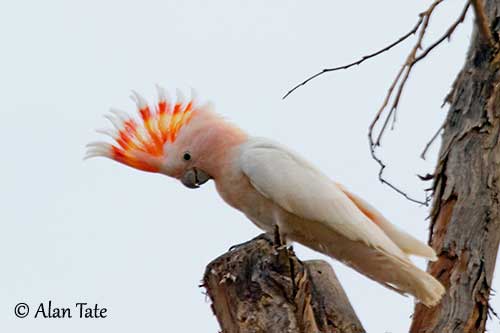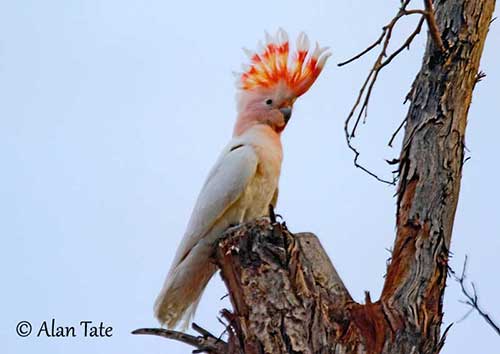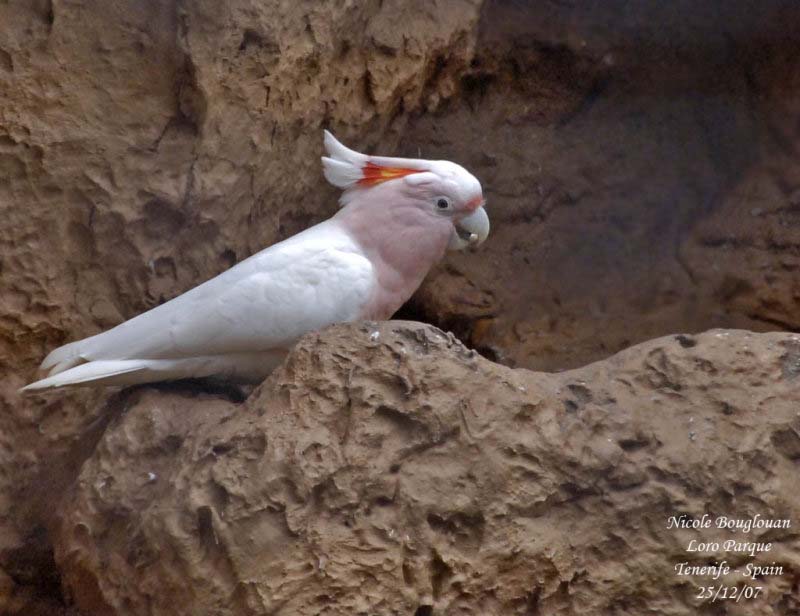
Pink Cockatoo
Cacatua leadbeateri
Psittaciforme Order – Cacatuidae Family
BIOMETRICS:
Length: 35 cm; Weight: 360 - 480 gr.
LONGEVITY: About 70 years
DESCRIPTION:
Its Latin name pays homage to the British naturalist Benjamin Leadbeater. Its other English name “Major Mitchell’s Cockatoo”, pays tribute to Major Thomas Mitchell who raved about the beauty of this bird.

Pink Cockatoo adult male has white upper parts, including wings and rounded tail.
On the underparts, chin, throat, breast and belly are salmon-pink. Undertail coverts are white, as undertail feathers which have pink bases. Under wings are suffused salmon-pink.
On the head, face and nape are salmon-pink. We can see pink-red frontal band and lores. On the crown, an elongated crest shows several colours. Frontal part of it is white. Other crest feathers are scarlet, barred with narrow, yellow central band. Crest is broadly tipped white.
Hooked bill is horn-coloured. Eyes are dark brown, with narrow, bare, white eye-ring. Legs and feet are grey.
Adult female resembles male, but she has paler head and underparts, with white upper belly instead pink. Her crest shows wider yellow band. She has pale reddish-pink eyes, and she is slightly smaller than male.
Juvenile is similar to female, with duller and paler plumage. It has pale brown eyes, and duller frontal band.
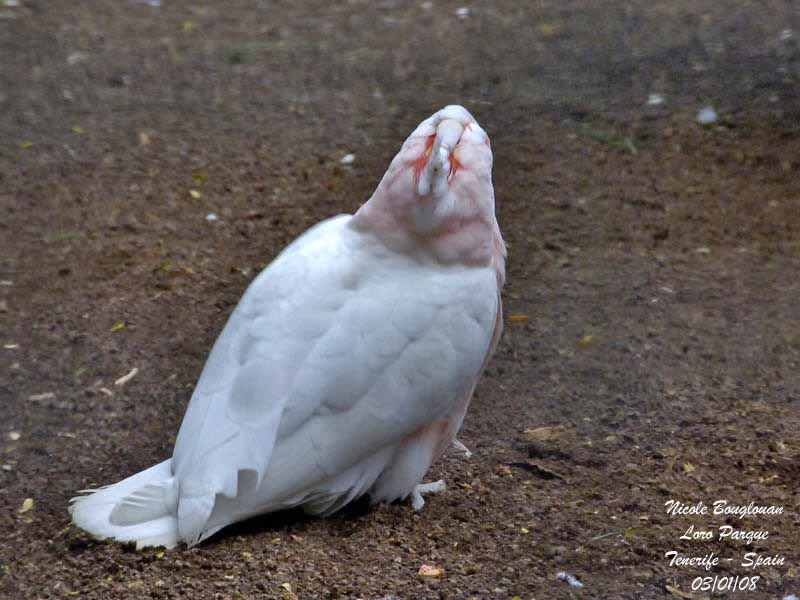
We find a subspecies, Cacatua leadbeateri mollis, with darker red crest barred or not with yellow band. It lives in western and central Australia.
VOICE: SOUNDS BY XENO-CANTO
Pink Cockatoo utters a repeated quavering “creek-ery-cree” in flight. Alarm call is the same sound, rapidly repeated, resulting in continuous screech.
HABITAT:
Pink Cockatoo frequents arid to semi-arid areas, with trees along streams and woodland with Callitris, Allocasuarina and Eucalyptus.
RANGE:
Pink Cockatoo lives in the interior of mainland Australia, except north-east. It can be found up to 300 metres of elevation.
BEHAVIOUR:
Pink Cockatoo breeding pair often has a territory of about two kilometres. This pair prevents other pair to breed in the area. But outside of breeding season, these cockatoos maintain contact with other pairs or non-breeding birds within groups. We can find flocks of 10 to 50 birds. Larger flocks can be formed at concentrated food sources.
In non breeding period, Pink Cockatoos occupy communal roosts at night.
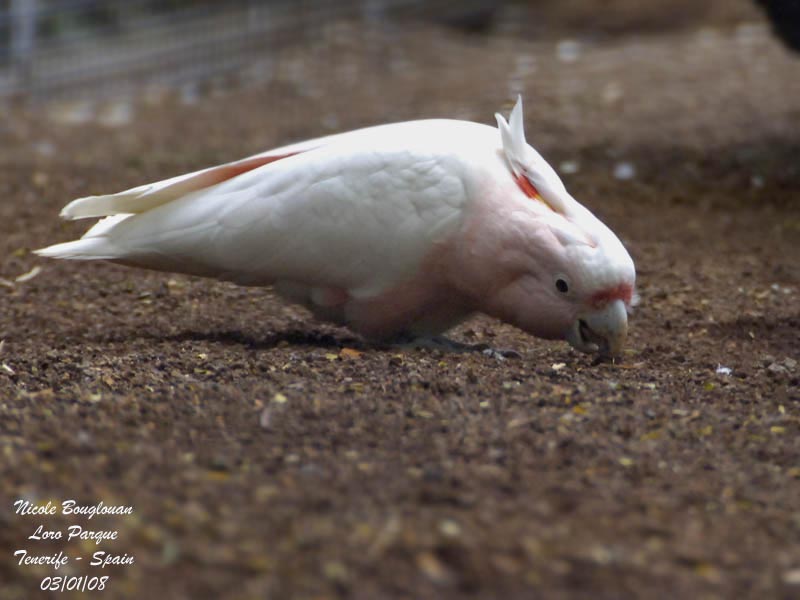
Pink Cockatoos feeds on the ground by walking slowly, or in watchful pose with its beautiful crest partially erected. It regularly stops in upright posture. It also feeds in trees and shelters from the heat among foliage. Both mates of the pair sit close to each other.
Pink Cockatoo is able to extract seed from hard nuts, thanks to its strong bill. It also extracts insect larvae from branches of Eucalyptus and Acacias.
Pink Cockatoo usually keeps the crest flat, but during displays, or when alarmed or excited, it raises this conspicuous crest, in order to court the female or to threaten a rival.
FLIGHT:
Pink Cockatoo performs slow, laboured flight, with shallow wing beats, interspersed with brief glides. It is not a strong flier, and rarely flies high. If it needs to travel long distances, it performs several short flights from tree to tree.
REPRODUCTION:
Breeding season occurs between August and October.
Pink Cockatoo pair usually returns to the same nest-hollow every year. The cavity can be renovated by chewing the sides of the entrance, in order to get a lining of woodchips.
Several pairs can nest in the same area, but nests are between one and two kilometres apart.
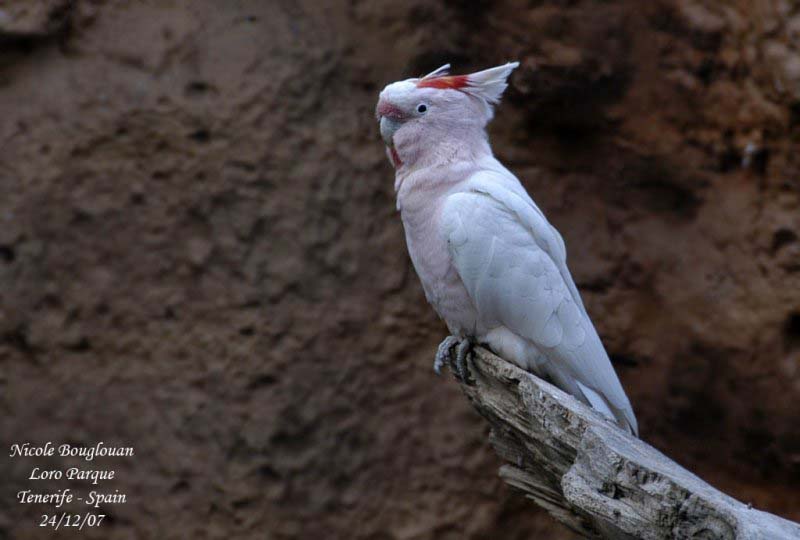
Female lays 2 to 5 eggs, one every 2-3 days. Incubation lasts about 23 to 24 days, shared by both parents.
Chicks remain at nest-hollow for about two months, and they are fed by the adults.
They remain in family groups near the nest until the young fledge. Then, they join other groups at food sources. Parents feed the young for three months and more after they have fledged.
The nomadic flock including family groups wanders over some distance, feeding and roosting together.
DIET:
Pink Cockatoo feeds mainly on the seeds of native or exotic melons, and also on the seeds of several pine species.
In addition, it also consumes waste cereal grain, seeds of several weeds and insect larvae from branches.
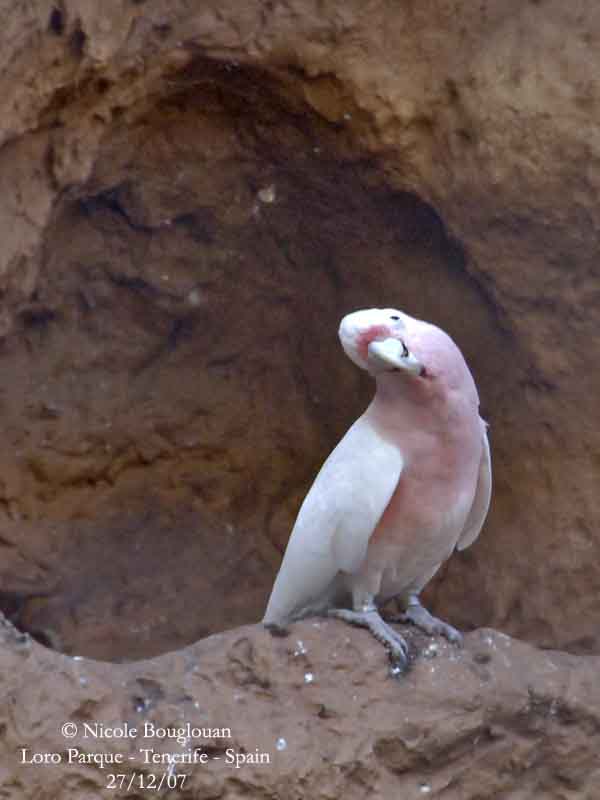
PROTECTION / THREATS / STATUS:
Pink Cockatoo is threatened by clearing of woodland, resulting in the loss of trees for nesting cavities, and by illegal trapping for trade.
This species is currently classified as Near-Threatened. However, the large flocks formed outside of breeding season appear very important. Populations need to be monitored and status depends of the region.
Fr: Cacatoès de Leadbeater
All : Inkakakadu
Esp : Cacatúa Abanderada
Ital : Cacatua di Leadbeater
Nd : Inka-kaketoe
Russe : Какаду-инка
Sd : Inkakakadua
PhotographeRs:
Alan & Ann Tate
AA Bird Photography
Nicole Bouglouan
PHOTOGRAPHIC RAMBLE
Text by Nicole Bouglouan
Pictures taken at Loro Parque – Tenerife- Canary Islands - Spain
Sources:
HANDBOOK OF THE BIRDS OF THE WORLD volume 4 by Josep del Hoyo, Andrew Elliot and Jordi Sargatal – LYNX EDICION – ISBN 8487334229
PARROTS OF THE WORLD – An Identification Guide – by Joseph M. Forshaw – Princeton University Press – ISBN 0691092516
Wikipedia (Wikipedia, The Free Encyclopedia)
